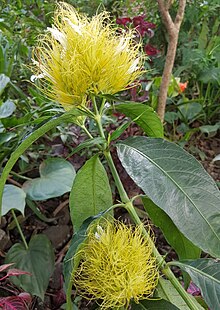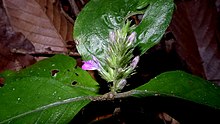
Justicia brandegeeana, the Mexican shrimp plant, shrimp plant or false hop, is an evergreen shrub in the genus Justicia of the acanthus family Acanthaceae, native to Mexico, and also naturalized in Florida.
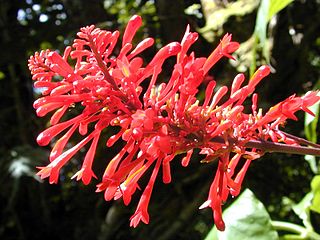
Acanthaceae is a family of dicotyledonous flowering plants containing almost 250 genera and about 2500 species. Most are tropical herbs, shrubs, or twining vines; some are epiphytes. Only a few species are distributed in temperate regions. The four main centres of distribution are Indonesia and Malaysia, Africa, Brazil, and Central America. Representatives of the family can be found in nearly every habitat, including dense or open forests, scrublands, wet fields and valleys, sea coast and marine areas, swamps, and mangrove forests.

Justicia is a genus of flowering plants in the family Acanthaceae. It is the largest genus within the family, encompassing around 700 species with hundreds more as yet unresolved. They are native to tropical to warm temperate regions of the Americas, India and Africa. The genus serves as host to many butterfly species, such as Anartia fatima. Common names include water-willow and shrimp plant, the latter from the inflorescences, which resemble a shrimp in some species. The generic name honours Scottish horticulturist James Justice (1698–1763). They are closely related to Pachystachys.

Acanthus is a genus of about 30 species of flowering plants in the family Acanthaceae, native to tropical and warm temperate regions, with the highest species diversity in the Mediterranean Basin and Asia. This flowering plant is nectar producing and is susceptible to predation by butterflies, such as Anartia fatima, and other nectar feeding organisms. Common names include Acanthus and Bear's breeches. The generic name derives from the Greek term ἄκανθος (akanthos) for Acanthus mollis, a plant that was commonly imitated in Corinthian capitals.

Strobilanthes kunthiana, kurinji or neelakurinji, is a shrub that is found in the shola forests of the Western Ghats in South India. Nilgiri Hills, which literally means the blue mountains, got their name from the purplish blue flowers of Neelakurinji that blossoms only once in 12 years. Of all long interval bloomers Strobilanthes kunthiana is the most rigorously demonstrated, with documented bloomings in 1838, 1850, 1862, 1874, 1886, 1898, 1910, 1922, 1934, 1946, 1958, 1970, 1982, 1994, 2006 and 2018, these have no match to Solar cycles.

Robert Wight MD FRS FLS was a Scottish surgeon in the East India Company, whose professional career was spent entirely in southern India, where his greatest achievements were in botany – as an economic botanist and leading taxonomist in south India. He contributed to the introduction of American cotton. As a taxonomist he described 110 new genera and 1267 new species of flowering plants. He employed Indian botanical artists to illustrate many plants collected by himself and Indian collectors he trained. Some of these illustrations were published William Hooker in Britain, but from 1838 published a series of illustrated works in Madras including the uncoloured, six-volume Icones Plantarum Indiae Orientalis (1838–53) and two hand-coloured, two-volume works, the Illustrations of Indian Botany (1838–50) and Spicilegium Neilgherrense (1845–51). By the time he retired from India in 1853 he had published 2464 illustrations of Indian plants. The standard author abbreviation Wight is used to indicate this person as the author when citing a botanical name.
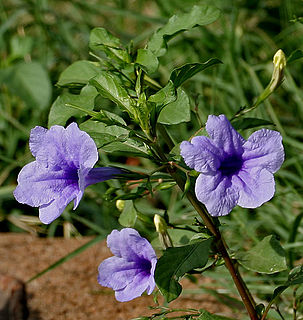
Ruellia is a genus of flowering plants commonly known as ruellias or wild petunias. They are not closely related to petunias (Petunia) although both genera belong to the same euasterid clade. The genus was named in honor of Jean Ruelle, herbalist and physician to Francis I of France and translator of several works of Dioscorides.

The campo rupestre is a discontinuous montane subtropical ecoregion occurring across three different biomes in Brazil: Cerrado, Atlantic Forest and Caatinga. Originally, campo rupestre was used to characterize the montane vegetation of the Espinhaço Range, but recently this term has been broadly applied by the scientific community to define high altitudinal fire-prone areas dominated by grasslands and rocky outcrops.
Anisotes is a genus of Afrotropical plants in the family Acanthaceae. The genus is morphologically similar to Metarungia, from which it differs mainly in the dehiscence of the fruit capsule, and the nature of the placenta. Placentas remain attached to the inner surface of fruit capsules in Anisotes.
Johannes Conrad Schauer was a botanist interested in Spermatophytes. He was born in Frankfurt am Main and attended the gymnasium of Mainz from 1825 to 1837. For the next three years he worked at the Hofgarten of Würzburg. Schauer then gained a position as assistant at the botanical garden at Bonn where he worked until 1832 when he was placed in charge of the botanic garden in Breslau, with C.G. Nees. He gained the degree of Doctor of Philosophy at the University of Erlangen-Nuremberg 1835 and was appointed professor of botany at the University of Greifswald from 1843 until his death in 1848.

Theodor Friedrich Ludwig Nees von Esenbeck was a German botanist and pharmacologist, who was born in Schloss Reichenberg near Reichelsheim (Odenwald). He was a younger brother to naturalist Christian Gottfried Daniel Nees von Esenbeck (1776–1858).
Justicia tobagensis is a species of plant in the family Acanthaceae which is endemic to Trinidad and Tobago. The species is only known from two areas in the Main Ridge of Tobago. It was first described as Drejerella tobagensis by German botanist Ignatz Urban in his Symbolae Antillanae, based on a collection made by Danish botanist Henrik von Eggers

Tetramerium is a genus of plants belonging to the family Acanthaceae. It is found mainly in the Americas, especially in tropical dry forests. Christian Gottfried Daniel Nees von Esenbeck first described the genus in 1846 after collecting two species on the journey of HMS Sulphur.
Dodecadenia is a botanical genus of flowering plants of the family Lauraceae. It is present from central Asia, to Himalayas and India. It is present in tropical and subtropical montane rainforest, laurel forest, in the Weed-tree forests in valleys, mixed forests of coniferous and deciduous broad-leaved trees, Tsuga forests; 2,000–2,600 metres (6,600–8,500 ft) in China in provinces of Sichuan, Xizang, Yunnan, and countries of Bhutan, India, Myanmar, and Nepal.

Lepidobolus is a plant genus in the family Restionaceae, described as a genus in 1846. The entire genus is endemic to Australia.
Thomas Franklin Daniel is an American botanist, and teacher. He is a specialist of the botanical family Acanthaceae. In 1975 he obtained his undergraduate from Duke University. In 1980, he obtained his doctorate at the University of Michigan. In 1981, he was assistant professor. Between 1981 and 1985 he was an assistant curator of the Arizona State University Herbarium.
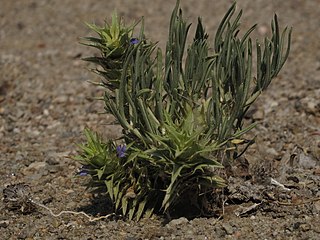
Blepharis grossa is a species of plant in the family Acanthaceae native to Angola, Namibia, and the Cape Provinces.
Plantae preissianae sive enumeratio plantarum quas in australasia occidentali et meridionali-occidentali annis 1838-1841 collegit Ludovicus Preiss, more commonly known as Plantae preissianae, is a book written by Johann Georg Christian Lehmann and Ludwig Preiss.
Thyrsacanthus is a genus of flowering plants in the family Acanthaceae, found in South America east of the Andes, typically in drier areas. Perennial shrubs, they were resurrected from Anisacanthus in 2010, leaving it with the North American species.
